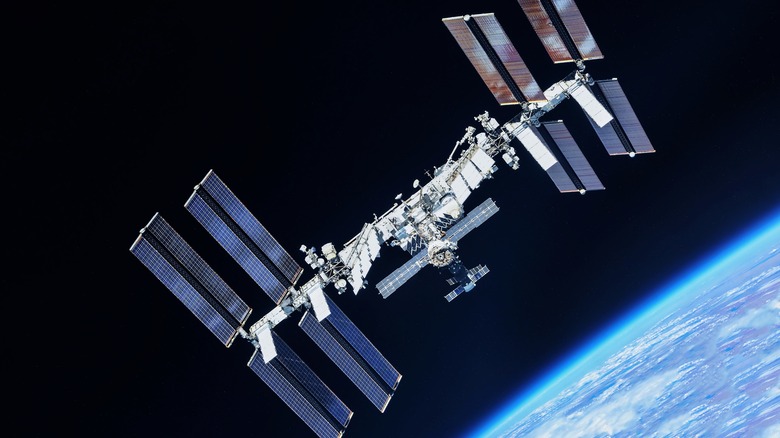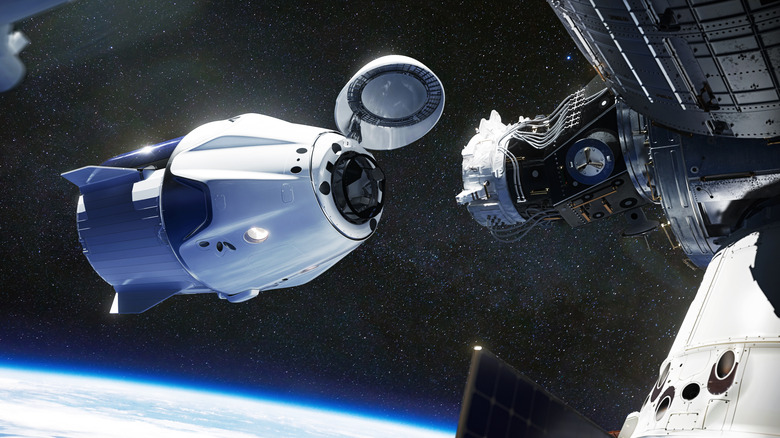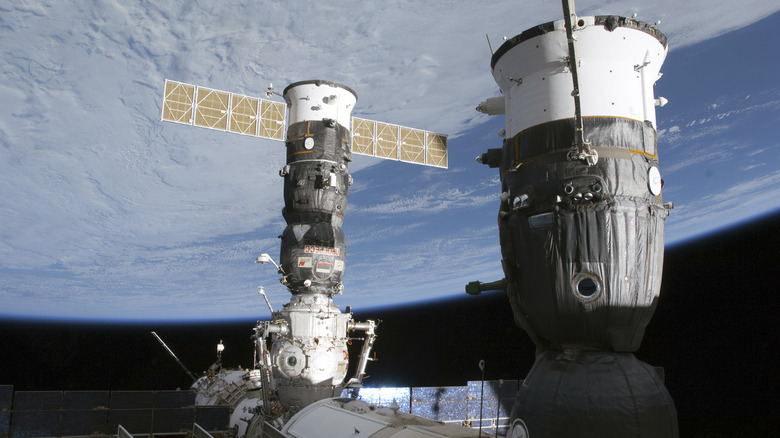Here's How The ISS Ship Docking System Works
Science fiction is a genre filled with astronauts and space pirates docking their ships with other ships and space stations. Unless it's "Star Trek," which uses its convenient transporter to, well, transport people, docking is an essential aspect of space travel. It's especially important in real life for scientific exploration. Even the Apollo command module required the technology to dock with the moon lander. Docking in space has become even more vital ever since the International Space Station (ISS) was ready to accept long term crew members in November 2000. Shuttles need to dock with it to get new crews aboard.
The ISS is a cooperative effort between Europe, the United States, Russia, Canada, and Japan, with each nation contributing to its construction. There are currently 43 separate modules that make up the entirety of the station, but just how does the docking system aboard the ISS work? As with everything in space, it's delicate and requires precision. The cabins need to remain pressurized, otherwise a portion of the station and docking shuttle would be ripped apart, sucking the astronauts out into the dark abyss that is space. Much in the same way that if a passenger somehow manages to open an airplane door above 10,000 feet, the cabin would depressurize and pull passengers out.
The ISS is no stranger to receiving visitors. Whether its receiving new supplies for the current crew aboard or rotating out an old crew with a new one, there's a regular schedule of visitors to the space station.
How does ISS docking work?
The ISS wasn't only built by several nations, it's also visited by a number of different countries and agencies — separate nations and companies that have different designs for their spacecraft. The whole project wouldn't work if shuttles and cargo crafts had to be built with different docking mechanisms. For this reason, the brain trust behind the ISS project had to come up with a way to standardize the docking process. It's called the International Docking System Standard (IDSS).
The standardized docking system is comprised of several parts: First, there's the transfer passageway, which is the opening of the system. Next, there's the soft capture system made up of latches and strikers. This portion of the docking system provides the first stage of the docking sequence, ultimately aligning the two structures that connect to each other. Once the soft capture system is secured, there's the hard capture system (HCS) that establishes a connection between the two vehicles capable of withstanding atmospheric pressure. That's the part where the station and the shuttle don't go boom thanks to depressurization.
The HCS is made up of the tunnel, two concentric pressure seals, two guide pins, and two receptacles. The pressurization process takes roughly two hours, so it's not as simple as clamping the latches and levers in place and going aboard. It's a delicate process that requires some patience. Once the tunnel is pressurized, astronauts are free to move between the shuttle and the ISS.
What spacecrafts visit the ISS
Since construction was completed on the space station in 2000, there have been over 70 "expeditions" to the ISS. The European Space Agency (ESA), Japan Aerospace Exploration Agency (JAXA), Roscosmos (Russian space agency), and NASA are frequent visitors to the lower orbit station. Several private entities have conducted their own missions or assisted with resupply missions, including SpaceX and Boeing.
The ISS is visited by the same four cargo spacecraft time and time again. Those spacecrafts are Northrop Grumman's Cygnus, SpaceX's Dragon, JAXA's HTV, and the Russian Progress. The first cargo craft to dock with the ISS was the Russian craft Progress on August 8, 2000, whereas the first crew to arrive on the station docked in November 2000, using Russia's Soyuz TM-31. SpaceX sent its first vessel — the Dragon cargo craft — to visit the ISS on May 12, 2012. Up to eight space crafts can be connected to the ISS simultaneously.
When a shuttle needs to dock with the space station, it's not as simple as parking a car. The shuttle's pilot will position the shuttle roughly 360 feet below the station, using the shuttles orbital maneuvering and reaction control systems. It inches ever so closer to the station with its nose and tail rockets, moving two inches per second until it's 33 feet from the station. From there, they will make adjustments and realign if necessary, and only then will they close the remaining distance — it's a precise process.
Countries that visit the ISS
The ISS has received over 270 astronauts and participants from over 20 countries. The first private company to venture to the station was Axiom Space's Axiom Mission-1, using SpaceX's Dragon vessel called "Endeavor." The United States has sent a total of 163 visitors, some of whom visited more than once. Russia to date has sent 57 astronauts, while 11 from Japan went, seven from Canada, six from Italy, with both France and Germany each sending four. Then there's a slew of other nations, from Belarus to the United Arab Emirates, who each sent one or two visitors.
The first crew to stay aboard the ISS arrived in November of 2000, and consisted of two Russian cosmonauts, Yuri Gidzenko and Sergei Krikalev, and one American astronaut, Bill Shepherd. NASA's space shuttle Discovery, the same shuttle that conducted one of NASA's most memorable missions, arrived at the station in March of 2001 with three new crew members to relieve the first crew.
Every visitor who travels to the ISS has an important role to fulfill, but docking with the station may be the single most important job for shuttle pilots. If a pilot isn't makes one error, it can be fatal for everybody aboard the station and shuttle. Pilots with NASA must fly for 15 hours every month in a Northrop's T-38 Talon to keep maintain their proficiency with flying.



